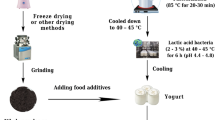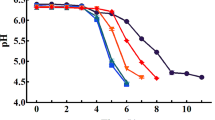Abstract
The aim of this study was to optimize the mixture proportion of low cholesterol mayonnaise containing wheat germ protein isolate (WGPI) and xanthan gum (XG), as emulsifying agents in mayonnaise preparation. The mayonnaise prepared with different combinations of WGPI, egg yolk (0–9 % of each component) and XG (0–0.5 %). The optimized mixture proportions of low cholesterol mayonnaise were determined by applying the optimal mixture design method to acquire the mayonnaise with proper stability, texture, rheological properties and sensory scores. Optimum values of WGPI, XG and egg yolk in the mixture were found to be 7.87 %, 0.2 % and 0.93 %, respectively (of 9 % egg yolk). The WGPI, due to unique functional properties, had the greatest effect on properties of mayonnaise samples. Moreover, combination of XG and WGPI, improved the stability, heat stability, viscosity, consistency coefficient and textural properties of product. However, the overall acceptance was maximum in a mixture contained high amount of WGPI and XG and low amount of egg yolk. The results of this research showed the feasibility of preparation a low cholesterol mayonnaise by application a desirable combination of WGPI, XG, and egg yolk, with comparable properties those of the conventional mayonnaise.








Similar content being viewed by others
Notes
Wheat Protein Isolate
Whey Protein Concentration
References
Abu Ghoush M, Samhouri M et al (2008) Formulation and fuzzy modeling of emulsion stability and viscosity of a gum–protein emulsifier in a model mayonnaise system. J Food Eng 84:348–357
Association of Official Analytical Chemists (2005) Official methods of analysis of the association of official analytical chemists, vol. II. Association of Official Analytical Chemists. Arlington, VA
Chantrapornchai W, Clydesdale F et al (1999) Influence of droplet characteristics on the optical properties of colored oil-in water emulsions. Colloids Surf A Physicochem Eng Asp 155:373–382
Cornell J (2002) Experiments with mixtures: designs, models, and the analysis of mixture data, 3rd edn. John Wiley and Sons, Inc., New York
Daugaard L (1993) Protein based emulsifiers for production of mayonnaise. Eur Food Drink Rev 7:52–54
Ge Y, Sun A et al (2000) Some nutritional and functional properties of defatted wheat germ protein. J Agric Food Chem 48:6215–6218
Gomez M, Gonzalez J et al (2012) Effect of extruded wheat germ on dough rheology and bread quality. Food Bioprocess Technol 5(6):2409–2418
Hassan HMM, Afify AS et al (2010) Nutritional and functional properties of defatted wheat protein isolates. Aust J Basic Appl Sci 4(2):348–358
Herald TJ, Abugoush M, Aramoun F (2009) Physical and sensory properties of egg yolk and egg yolk substitutes in a model mayonnaise system. J Texture Stud 40:692–709
Juszczak L, Fortuna T et al (2003) Sensory and rheological properties of polish commercial mayonnaise. Die Nahrung 47(4):232–235
Laca A, Saenz MC et al (2010) Rheological properties, stability and sensory evaluation of low-cholesterol mayonnaises prepared using egg yolk granules as emulsifying agent. J Food Eng 97:243–252
Liu H, Xu XM et al (2007) Rheological, texture and sensory properties of low fat mayonnaise with different fat mimetics. LWT 40:946–954
McClements DJ (1999) Food emulsions; principles, practice, & techniques. CRC Press, Boca Raton
McClements DJ, Demetriades K (1998) An integrated approach to the development of reduced fat food emulsions. Crit Rev Food Sci Nutr 38:511–536
Mun S, Kim YL et al (2009) Development of reduced-fat mayonnaise using 4[alpha] GTase modified rice starch and xanthan gum. Int J Biol Macromol 44(5):400–407
Narsimhan G, Wang Z (2008) Guidelines for processing emulsion-based foods. In: Hasenhuettl GL, Hartel RW (eds) Food emulsifiers and their applications. Springer Sci Business Media, New York, pp 349–389
Raymundoa A, Franco J et al (2002) Optimization of the composition of low fat oil-in water emulsions stabilized by white lupin protein. J Am Oil Chem Soc 79(8):783–789
Rir L, Feldman L et al (1994) Surface properties and emulsification behavior of denatured soy protein. J Food Sci 59:606–607
Sathivel S, Bechtel P et al (2005) Functional, nutritional, and rheological properties of protein powders from Arrowtooth Flounder and their application in mayonnaise. Food Eng Phys Prop 70(2):57–63
Takeda K, Matsumura Y et al (2001) Emulsifying and surface properties of wheat gluten under acidic conditions. J Food Sci 66:393–399
Worrasinchai S, Suphantharika M et al (2006) B-glucan prepared from spent brewer’s yeast as a fat replacer in mayonnaise. Food Hydrocoll 20:68–78
Wrolstad RE, Acree TE et al (2005) Handbook of food annalytical chemistry. John Wiley and Sons, Inc., Hobkon, New Jersey
Zhu KX, Zhou HM et al (2006) Proteins extracted from defatted wheat germ: nutritional and structural properties. Cereal Chem 83(1):69–75
Acknowledgments
The authors gratefully acknowledge Tabarestan Technology Incubator, Saari, I.R. Iran for cooperation in rheological measurements and technical assistance.
Author information
Authors and Affiliations
Corresponding author
Rights and permissions
About this article
Cite this article
Rahbari, M., Aalami, M., Kashaninejad, M. et al. A mixture design approach to optimizing low cholesterol mayonnaise formulation prepared with wheat germ protein isolate. J Food Sci Technol 52, 3383–3393 (2015). https://doi.org/10.1007/s13197-014-1389-4
Revised:
Accepted:
Published:
Issue Date:
DOI: https://doi.org/10.1007/s13197-014-1389-4




